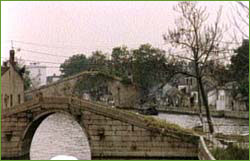
|
 |
The Rainbow Bridge built in the NOVA program "China Bridge" is just one of many important inventions that appeared during China's impressive Song Dynasty (A.D. 960-1280). This vibrant period in Chinese history was marked by economic prosperity and remarkable technological innovation. Read on to find out what China expert Robin D. S. Yates, Professor of History and East Asian Studies at McGill University in Montreal, Quebec, Canada has to say about this exceptional era - and how it influenced the course of world history. NOVA: Let's begin by providing a worldwide context for the Song Dynasty. In 1271, the Italian merchant Marco Polo is believed to have visited China. What was his impression of this very different world? Yates: Well, there's a debate as to whether Marco Polo ever did, in fact, visit China. However, assuming Polo's account is real, what comes across most obviously is that he was utterly astonished at the size of the cities and the extent of commercial activity in China. The number of ships on Chinese canals and rivers far exceeded what Polo was familiar with in the cities of Italy, such as Venice or Genoa. The Chinese had a very cultured and civilized society. Song Dynasty silks, for example, were remarkably advanced. The Chinese were using very sophisticated looms with up to 1,800 moving parts. China was simply far more developed technologically and culturally than any state in the West. But one wonders whether Polo had actually visited, because of the things that he doesn't write about at all. He doesn't mention paper money and the bank note, which were both invented during the Song Dynasty. You would have thought that if he'd lived there for 20 years, he might have noticed it, because Western Europe didn't have it.
Yates: There is a strong connection between the increasing urbanization and the burgeoning commercialization of Chinese culture at this time. Merchants traveled from one place to another, and a new group of scholar-officials was appointed to administer the country. The traveling merchants and officials wanted to eat the cuisine that they were used to in their local region. And people with some extra wealth in the urban centers also wanted to try food from different regions. So what developed was a new urban type of culture that included eating out in restaurants and the drinking of tea. It was really in the Song Dynasty that tea reached its cult status. It was drunk out of very beautiful, extraordinarily exquisite tea bowls made from porcelain, one of the glories of the Song Dynasty. The word "china" is appropriate for porcelain, because the Chinese developed the technology for its production. The Song Dynasty ceramic industry was basically the first commercialized industry. They produced the pieces in mass quantities for the imperial palace, but also for this newly arisen class of scholar-officials and an urban elite and for these restaurants. Eventually, two of the main products the West wanted in the 17th, 18th, and 19th centuries were porcelain and tea, so much of the trade between East and West was based on those items. With restaurants, common folk could eat out very, very cheaply on food such as fried noodles, which, it is said, Marco Polo introduced to the West. Although there's a lot of debate about that, the idea of spaghetti probably comes from China at about the time of the Song, possibly carried across the ocean by Arab traders, who are known to have established themselves in ports such as Canton by the ninth century.
Yates: Gunpowder completely transformed the way wars were waged and contributed to the eventual establishment of might over right. In my own research, I have been able to refute the common notion that the Chinese invented gunpowder but only used it for fireworks. I'm sure that they discovered military uses for it. I have found the earliest illustration of a cannon in the world, which dates from the change-over from the Northern Song to the Southern Song around 1127, which was 150 years before the development of the cannon in the West. The Song also used gunpowder to make fire lances - actually flame throwers - and many other gunpowder weapons, such as anti-personnel mines, which are thankfully now being taken out of general use. Needless to say, the cannon was used by the kings of Europe to fundamentally alter the social structure of the European world. It enabled kings to destroy the castles of the feudal lords. And it enabled, therefore, the centralized nation-state to develop. By the end of the Song Dynasty, the Chinese invented multiple-stage rockets. If we hadn't had that, maybe we would not have been able to put a man on the moon. It was that fundamental an idea. Joseph Needham, an historian of Chinese science and technology, also argues that the notion of an explosion in a self-contained cylinder also permitted the development of the internal combustion engine and the steam engine. Our basic modes of transportation would not have been possible without this Chinese invention. NOVA: How did the Chinese invention of gunpowder move from East to West? Yates: Although scholars often consider the Song Dynasty to have been very weak, its use of gunpowder was the reason it was able to hold off the Mongols for many decades. Eventually, the Mongols were able to capture Chinese artisans and use the latest gunpowder technology against the Chinese. The Mongols used those people who had a special knowledge of technology and employed them in their own armies as engineers. They carried that technology to the West very rapidly because it was very helpful in their conquests. What was interesting with this transfer of technology is that it goes both ways. After the introduction of the cannon and gunpowder to the West, Westerners very quickly became expert with cannons. They cast bronze cannons that were eventually much better than those the Chinese could produce. The Western bronze cannon was then brought back to China by the Jesuits in the 16th and 17th centuries. The Ming Dynasty, which fought the Manchus, employed Jesuit priests to cast cannons that were more advanced than the Chinese had at that time.
Yates: Printing and movable type were certainly two of them. Printing was actually invented by the Buddhists in the eighth century for dissemination of religious images and texts. But in the Song Dynasty, the government promoted the publication of the Confucian texts called "The Canons." These texts had to be studied by examination candidates. Once you passed the examinations you were eligible to become an official. So many copies of the Confucian texts were published at this time. In addition, the government popularized the use of printing for the dissemination of technical manuals, such as agricultural manuals and works on medicine. Eventually, private printing presses started, which fundamentally altered the world of letters and dissemination of knowledge. In the 11th century, a famous literary artist by the name of Shen Gua records the invention of movable-type printing by a man by the name of Bi Sheng. It was this invention that was eventually taken over to the West and used by Gutenberg for the printing of the Bible. Needless to say, this had a profound effect on the nature of knowledge and the development of literature. So this is probably the number-one invention of the Song Dynasty. NOVA: Did the development of printing change China the way it would change Europe? Yates: The effect of printing was different in East and West because of the nature of the Chinese language. The Chinese language, when it is written, uses characters or graphs, sort of like ideograms. It is not an alphabet like we know it. As a consequence, there are literally thousands of Chinese characters. Obviously for most types of writing, you don't need the 48,000 different Chinese characters. You only need to use 3,000 to 10,000, something like that. Movable-type printing was more practical, with a very limited number of symbols, such as the letters used in European alphabetic languages. In Chinese writing, you had to have a very large number of characters, each individually carved to set in the press. So even though they invented movable type, it actually was never as useful as wood-block printing—carving the blocks of each page separately and independently. So that was the reason why there were some books printed using movable type, but it never really replaced wood-block printing in the way it did in the West. NOVA: Was movable type another example of technology moving from East to West, or was it an example of an innovation developing in the East and West simultaneously? Yates: It's very unclear, but it does appear that there was a transfer from East to West. The Mongol invaders of China were able to use their highly developed organization and cavalry to conquer all of Central Asia, including parts of India, the Middle East, and Europe. So the invention was probably transferred to the West as a result of the opening up of the trade routes and the lines of communication established by the Mongols. I'm not saying that Gutenberg actually had access to a Chinese press; that's highly unlikely. Rather, he probably got wind of the idea of printing through some unknown and lost source. It's rather ironic that Gutenberg was recently voted the man of the millennium, when it was the Chinese who actually invented the technology. Continue: the influence of printing innovations on Chinese history NOVA Builds a Rainbow Bridge | Bridge the Gap | Nature's Miracle Material China's Age of Invention | Resources | Transcript Medieval Siege | Pharaoh's Obelisk | Easter Island | Roman Bath | China Bridge | Site Map Editor's Picks | Previous Sites | Join Us/E-mail | TV/Web Schedule About NOVA | Teachers | Site Map | Shop | Jobs | Search | To print PBS Online | NOVA Online | WGBH © | Updated November 2000 |
 Marco Polo marveled at the commercial activity of
cities such as Suzhou, pictured here.
Marco Polo marveled at the commercial activity of
cities such as Suzhou, pictured here.
 Chinese invented restaurants to serve traveling
officials and merchants.
Chinese invented restaurants to serve traveling
officials and merchants.
 Gunpowder was used in Chinese rocket launchers to
shoot fireworks - and weapons of war.
Gunpowder was used in Chinese rocket launchers to
shoot fireworks - and weapons of war.
 The development of printing enabled Chinese officials
to distribute important documents.
The development of printing enabled Chinese officials
to distribute important documents.